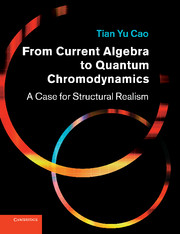Book contents
- Frontmatter
- Contents
- Preface
- 1 Introduction
- 2 The rise of current algebra
- 3 Sum rules
- 4 Saturation and closure
- 5 Scaling
- 6 Theorizations of scaling
- 7 The advent of QCD
- 8 Early justifications and explorations
- 9 Structural realism and the construction of QCD
- 10 Structural realism and the construction of the CA–QCD narrative
- References
- Author index
- Subject index
4 - Saturation and closure
Published online by Cambridge University Press: 06 December 2010
- Frontmatter
- Contents
- Preface
- 1 Introduction
- 2 The rise of current algebra
- 3 Sum rules
- 4 Saturation and closure
- 5 Scaling
- 6 Theorizations of scaling
- 7 The advent of QCD
- 8 Early justifications and explorations
- 9 Structural realism and the construction of QCD
- 10 Structural realism and the construction of the CA–QCD narrative
- References
- Author index
- Subject index
Summary
Gell-Mann's idea of current algebra as a physical hypothesis was rendered testable by Adler's sum rules. The success of the Adler–Weisberger zero momentum transfer sum rule testing the integrated algebra gave credit to Gell-Mann's general idea. But what about Adler's nonzero momentum transfer sum rules testing local current algebra? When Bjorken raised the issue of how the nonzero momentum transfer sum rule might be satisfied to Adler, at the Varenna summer school in July 1967 when both Adler and Bjorken were lecturers there, it seemed to be a very serious problem to Adler, since all the conceptual development up till then left undetermined the mechanism by which the nonforward neutrino sum rules could be saturated at large q2. After the Solvay meeting in October, 1967, Adler discussed this issue with his mentor Sam Treiman, and “then put the saturation issue aside, both because of the press of other projects and concerns, and a feeling that both shared that how the sum rule might be saturated ‘would be settled by experiment’ ” (Adler, 2003, 2009, private communications).
The response by Adler and Treiman to Bjorken's question seemed to be natural. How could anything else but experiments be the ultimate arbitrator for a physical hypothesis? However, as we will show, solely relying on experiments missed an opportunity to use the exploration of mechanisms for saturating the sum rule as a way to go beyond the conservative philosophy of the current algebra program, which was to abstract from field theory relations that might hold in general field theories, rather than searching for particular attractive field theory models that might underlie the general relations.
- Type
- Chapter
- Information
- From Current Algebra to Quantum ChromodynamicsA Case for Structural Realism, pp. 64 - 87Publisher: Cambridge University PressPrint publication year: 2010



